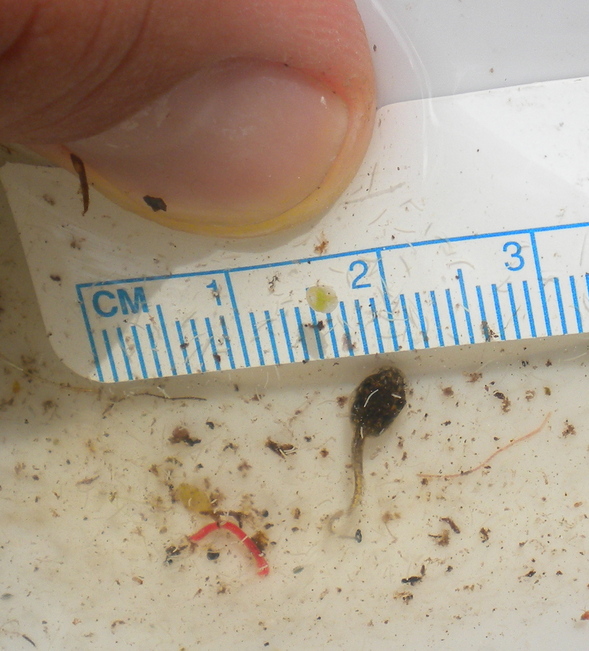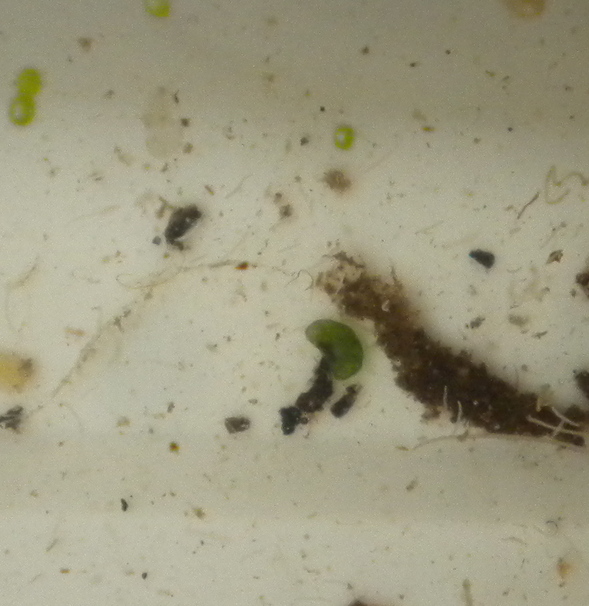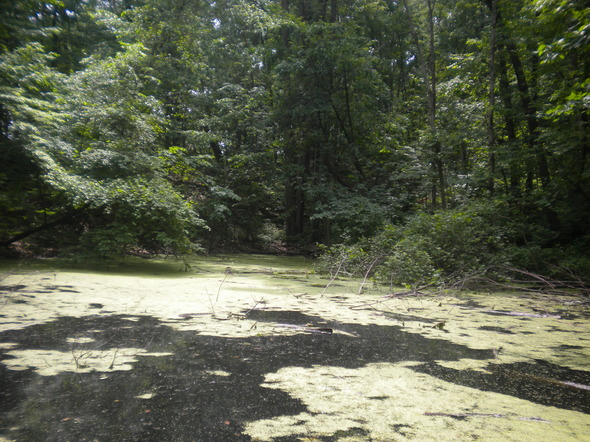Mystery organism identified: the flatworm, Dalyellia viridis
As each year goes on, so changes the pond. It fills with rain and melted snow/ice each spring, drying out each fall. Duckweed emerges in spring, covering the pond by summer’s start. Animal species appear each year in a somewhat predictable sequence from the moment the ice melts.
But each year one or two categories of animals seem to dominate. A few years ago, we had a wet summer leading to an abundance of frogs, spring peepers calling well into fall. Another year, mosquito larvae were in such abundance that I considered sampling them as an alternative protein source. This year, 2010, marks the year of the flatworm.
Even when the pond was covered with ice, small (2 millimeters), white organisms that look like floating threads were seen. While some of these were aquatic worms (Phylum: Annelida → Class: Oligochaeta → Order: Haplotaxida → Family: Naididae → Genus: Nais sp.) others of these were unidentified flatworms (Phylum: Platyhelminthes → Class: Turbellaria → various families).

Flatworms from the class Turbellaria (white, 2 millimeters long) can be seen floating over the ruler below my thumb. Below the ruler are 3 organisms (left to right): non-biting midge larvae (red), a tadpole, and an aquatic earthworm (red, looks like a thread).
Flatworms belong to the phylum Platyhelminthes. Flatworms are the simplest of animals that have bilateral symmetry (the right side and left side are mirror images of each other) and possess three basic cell layers. Flatworms lack segments, guts and an anus. Food goes in and waste is expelled through the same hole. Their brains are simply bundles of nerves that, depending on the species, may be connected to light receptors (simple eyes), chemical receptors, balance receptors, and water movement receptors if any or all of these receptors are present.
Today, it seems as if one cannot take a pond sample without collecting a great number of flatworms. These organisms can best be viewed with a dark backdrop, such as a dead leaf. I cannot recall seeing so many in my visits to Black Pond over the past 16 years. On the other hand, I haven’t been tuned in to seeing them. So perhaps they have been there all along?
Humans most often think of harmful flatworms, such as tapeworms or parasitic flukes. Of the known flatworms more than half are parasitic. Some of these parasites, such as the trematodes (flukes) spend time in water before infecting an aquatic host species, which is then eaten by a bird or mammal. The bird or mammal spreads the parasite to new water sources through their feces. This is a great reason to scoop your pet’s poop in the woods, even if that means keeping them on their leash so you know when they go.
But more than likely, the flatworms in Black Pond are free-living flatworms belonging to the Class Turbellaria. Turbellarians are also known as planarians, although planarians are just one Order of this Class. There is debate in the scientific community as to how to organize this Turbellaria and Platyhelminthes in general. We’ll keep on top of this developing story. Look for an update in a decade or so.
One flatworm has been haunting me for the past month. I’d seen it years ago, but didn’t know what it was. Now I do. This green, oval-shaped, 2-3 millimeters long organism that moves and changes shape is known as Dalyellia viridis (Dolly-el-ee-uh Veer-ee-dees).

Dalyellia viridis, the mystery organism (2-3 millimeters long).
(Phylum: Platyhelminthes → Class: Turbellaria → Order: Neorhabdocoela → Family: Dalyellidae → Genus: Dalyellia → Species: viridis)
Dalyellia is common in ponds throughout Europe and North America. One or more species of Dalyellia can be found in most stagnant freshwater pools both permanent and temporary. Dalyellia is green due to the presence of symbiotic algae inside its body. Unknown are the factors that cause Dalyellia eggs to hatch some weeks after a pond fills.
Unlike many free-living flatworms that are predatory, Dalyellia is a scavenger, feeding on detritus - the small pieces dead plant and animal material in the pond water. This week’s video pondcast (Pondcast - Week 22) has a clip of Dalyellia, an ostracod (seed shrimp), and a small unidentified (Turbellarian) flatworm feeding.
In attempting to identify this organism, I’ve taken a few other videos under the microscope:

Black Pond on June 3.
For those of you starting out in identifying critters found in your pond, here are a few resources I’ve discovered. Unfortunately, none of them include Dalyellia. But these are wonderful resources:
- The basic pond critter identification key that we use at Black Pond
- Catalog of Aquatic Macroinvertebrates from the Battle Ground School District in Battle Ground, Washington and as a PDF for printing
- EPA’s Bioindicators
- UM Dearborn’s Environmental Interpretive Center’s Identifying Aquatic Insects
- Clinton River Watershed Council’s Common Macroinvertebrates
You can see all the Pondcast videos by visiting the YouTube channel of Stefan Szumko, AKA slugwhisperer at http://www.youtube.com/user/slugwhisperer.
Stefan Szumko is a middle school science teacher by trade, an outdoor environmental educator by calling, and a homedaddy by choice. He can be reached at slugwhisperer@gmail.com.
Stefan is so grateful to those who provided assistance in the identification of the mysterious Dalyellia viridis.

